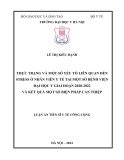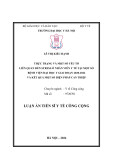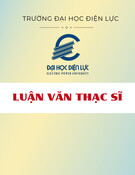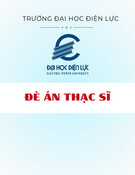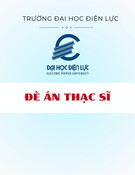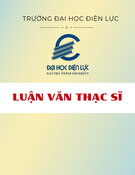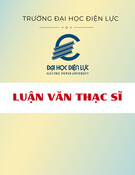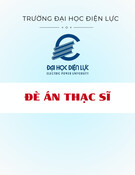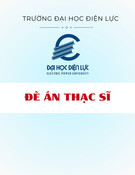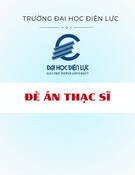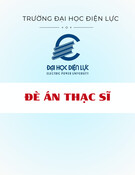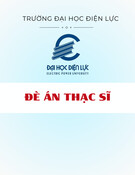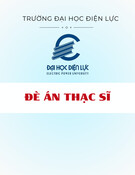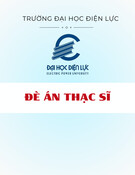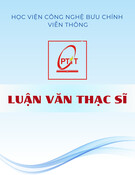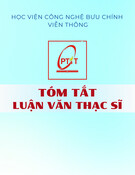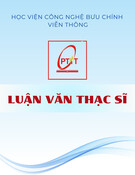
MINISTRY OF TRAINING AND
EDUCATION
MINISTRY OF HELATH
HAI PHONG UNIVERSITY MEDICINE AND PHAMARCY
VU THI CHAU
EVALUATION OF THE IMMUNOGENICITY AND
SAFETY OF IVACFLU-A / H5N1 VACCINE
IN HEALTHY ADULT VIETNAMESE
Sector: Public health
Code : 9720701
SUMMARY OF PUBLIC HEALTH DOCTORALTHESIS
HẢI PHÒNG - 2021

THE RESEARCH HAS COMPLETED AT
HAI PHONG UNIVERSITY MEDICINE AND PHAMARCY
Doctoral advisor:
1. Asoc Prof. Vu Đinh Thiem, PhD
2. Asoc Prof. Đang Van Chuc, PhD
Reviewer 1: Prof. Tran Quoc Kham, MD, PhD
Ministry of Health
Reviewer 2: Asoc Prof. Nguyen Dang Dung, MD, PhD
Military Medical University
Reviewer 3: Asoc Prof. Chu Van Thang, MD, PhD
Hanoi Medical University
The dissertation will be examined by Examination Board of
Hai Phong University of Medicine and Phamarcy
At: hour day month year 2021.
This thesis can be found at:
1. National Library
2. Hai Phong University of Medicine and Phamarcy Library

1
INTRODUCTION
Influenza is one of the infectious diseases with the potential to
pose a great threat to people, it is not only the adverse health effects of
annual influenza outbreaks, but also the enormous global consequences
of these outbreaks or pandemic influenza. During pandemic influenza A
/ H1N1 (2009) and the spread of influenza A / H5N1 virus among avian
influenza transmitted to human populations, this shows the
unpredictability of influenza viruses.
Although influenza A / H1N1 (2009) pandemic has subsided and the
pandemic virus is considered as seasonal influenza virus, but the threat of a
influenza pandemic which cause by avian influenza A / The H5N1, might
be still latent and break out suddenly at certain time. Since 1997, the avian
influenza A / H5N1 virus has a high pathogenicity that has caused
widespread outbreaks in poultry with a very high mortality rate, while it
also caused sporadic, severe and fatal illness for people. Southeast Asian
countries including Vietnam, have been affected by the influenza A /
H5N1. According to WHO report from 2003 to October 2020, there were
861 confirmed cases of influenza A / H5N1, of which 455 died. Southeast
Asian countries account for 42% of influenza A / H5N1 virus infections
reported since 2003 and A / H5N1 influenza infection in animals is still
considered localized in the region curently. As of October 2020, Vietnam
had 127 human cases of A / H5N1 influenza, of which over 50% died
(64/127) . Therefore, the risk of AH5N1 influenza virus transmission from
poultry to humans is still present.
Therefore, research and production of domestic vaccines for
prevention of influenza to actively and promptly in the fight against the
pandemic, the dependence from the vaccine by foreign suppliers, the
appropriate cost of vaccines, the help for increasing in the number of
people to have access to influenza vaccine, it is important task for
proactively prevent epidemics and minimizing the spread in the
community. From that actual, the Ministry of Health has assigned the

2
Institute of Vaccines and Medical Biologicals (IVAC) to research and
produce A / H5N1 influenza vaccine, to hold the initiative source
vaccines for domestic demand. IVAC based on the technical and
financial support from WHO to build an influenza vaccine production
line according to GMP-WHO standards with a potential capacity of up
to 3 million doses per year by embryonic technology, that technology
currently provides about 80% of the influenza vaccine for using in the
world. In order for register of marketing authorisation of a new vaccine
product, it is necessary to get data on clinical trials to confirm the safety
and immunogenicity of that product. Therefore, a question arises as to
whether the vaccine against influenza A / H5N1, commercially known as
IVACFLU-A / H5N1, meets the standards of safety and
immunogenicity? We conducted the research topic: “Evaluation of the
immunogenicity and safety of IVACFLU-A / H5N1 vaccine in healthy
adult vietnamese”. This research consists two following objectives:
1. Evaluation of the immunogenicity of IVACFLU-A / H5N1 vaccine
produced by the Institute of Vaccines and Medical Biologicals at a dose
of 15mcg.
2. Evaluation of the safety of IVACFLU-A / H5N1 vaccine produced by
the Institute of Vaccines and Medical Biologicals at a dose of 15mcg.
The new scientific and practical values contributions of the
research:
- The research has topical, practical and urgent significance on
the safety and immunogenicity of the avian influenza vaccine named
IVACFLU-A / H5N1 produced by Vietnam to hold the initiative in
source vaccines for human diseases.
- Currently, vaccine production in Vietnam has been quite
proactive and promptly self-produced a number of vaccines to prevent
diseases, especially in the Expanded Programme on Immunization,
including domestic influenza vaccine, with independence on vaccines
supplied by foreign countries. The success of domestic influenza
vaccine production has helped for reducing the cost of influenza

3
vaccine, for increasing in the number of people to be able to access the
influenza vaccine, it is contributing to proactively preventing epidemics
and limiting disease spread in community.
- After the research results are completed and effectively, Vietnam is
going to have a new vaccine for widely applying in the community to
prevent influenza A / H5N1 pandemic from poultry to humans.
The structure of thesis:
This thesis consists of 122 pages (excluding references, appendices),
include: Introduction (02 pages), Chapter 1: overview (24 pages),
Chapter 2: objects and methodology (22 pages), Chapter 3: results (45
pages), Chapter 4: discussion (25 pages), Conclusions (2 pages),
Recommendations (1 pages). The thesis includes 30 tables, 11 charts,
03 diagrams, 106 references (including 14 in Vietnamese) and
appendices.



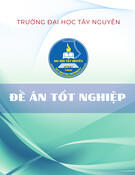
![[2024] Tỉ lệ nhiễm Trichomonas tenax & Yếu tố liên quan ở bệnh nhân viêm nha chu tại Bệnh viện Đa khoa Vùng Tây Nguyên: Đề án Thạc sĩ](https://cdn.tailieu.vn/images/document/thumbnail/2025/20250709/daiduogxanh/135x160/72341752050179.jpg)



